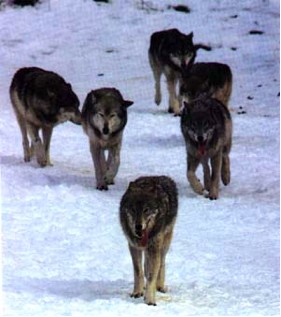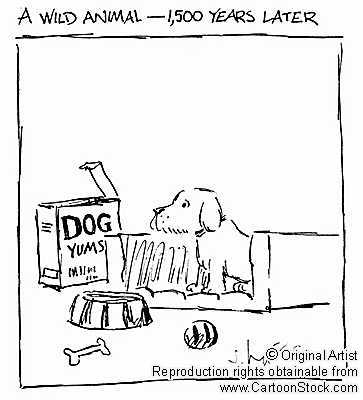Tameability and Domestication
Bio 342 By Alex Winters
Phylogeny
How traits evolve differently in natural vs domestic
conditions 
Whether it happened artificially (as is in the farm-fox experiments that selected for tameability) or naturally (as a theory for how dogs evolved) or a combination thereof, domestication is an evolutionary process that involves a changing environment (new situations) influencing allele frequency favoring certain mutations that allow the animal to breed more in the new niche. But while the end result may be the same (even indistinguishable) the two processes proceed differently. (Trut et al 2004; Fox 1978).
Natural conditions
Under natural conditions, a new trait (such as dogs’ ability to read human social cues) that has occurred through mutation allows an animal to fill a new niche or take advantage of a new situation.The case of humans and dogs
The appearance of groups of humans allowed dogs to follow these groupings and get access to food and possible predator protection. If a few dogs who had this new ability were more successful (in terms of number of offspring) then this could lead to extinction of the first species in favor of the new one or speciation. If a new species broke off from the main group, change in niche environments between the two species might reduce or eliminate the possibility of interbreeding. The new species would then be concentrated in the new environment leading to further selective pressure to adapt that niche. This would lead to the honing of traits that encouraged survival and reproduction for those animals. (Dogs became more and more in tune with humans in order to better their use of human cues to find food.) Depending on the future environmental conditions this could lead one species to survive and dominate the other or the two to coexist in separate environments. (Hare & Tomasello 2005).Domestic conditions
Under domestic conditions, a change in human culture provides a new niche for animals with certain mutations that are better adapted to the new environment. These animals may be bred by humans for food, work, protection, and transportation. The same
selection
pressures are exerted on species with some animals having better access
to food (fed by humans), lower probability of death (protection and
veterinary care), and more ability to reproduce (directed animal
husbandry). This can cause speciation or whole scale change of a
species if noncompetitive members cannot survive in other environments
or if their previous niches no longer exist (due to human action like
deforestation). (Diamond 2002).
transportation. The same
selection
pressures are exerted on species with some animals having better access
to food (fed by humans), lower probability of death (protection and
veterinary care), and more ability to reproduce (directed animal
husbandry). This can cause speciation or whole scale change of a
species if noncompetitive members cannot survive in other environments
or if their previous niches no longer exist (due to human action like
deforestation). (Diamond 2002).